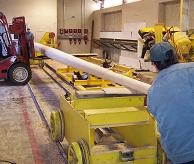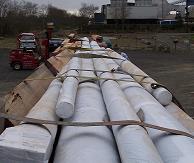The spar- and mast-making process; our Job Shop
| Selecting timber A quality job for your sailboat or custom house begins with premium logs. Spar Shop staff travel to the forest to meet with the land owners forester. We select two or more trees for felling. After the trees are downed they are limbed and moved to a landing where they are carefully examined. Logs may be rejected for pitch pockets, signs of rot, twist, or damage from the felling process. If defects are found in a log we purchase for you, we will acquire a new log and complete the project at no additional cost to you. |

|
| Transporting a log Selected wood logs are trucked to our Historical Seaport Spar Shop facility, a 10,000-square-foot drive-through building where our five-ton bridge crane unloads the logs and positions them for milling into cants. For oversize logs we use specialized equipment to get the job done. After milling them square and true, centers are marked and the cant is moved into our 144-foot long lathe room for turning to customer specifications. Hydraulic lifts position the cant on the lathe; steady rests are set up to support the cant as it turns, keeping it centered and reducing vibration. |

|
| Turning and tracking Once the steady rests are set, the tracer rail is set in position for the shape of the job and locked down. This 122-foot long ribbon of steel is one inch thick, three inches tall and once secured in place it establishes the shape that the cutter-head will trace into the log with each pass. The lathe turns at 12 to 20 rpm, depending on the log diameter. The high-speed cutter-head travels on a servo-motor driven car moving in or out as it follows the tracer rail. A series of fairly deep passes "trues" the log to round and establish the taper(s) prior to the final finishing passes. |

|
| To track the shape and the progress, the Spar Shop has a 122-foot whiteboard where measurement stations are marked and changes tracked throughout the process. Although most spar or mast work allows for plus or minus 1/4 inch, by slowing the process, tighter tolerances are possible. | |
| Special treatments and shipping Specialty cutters and attachments can create shoulders, beads, and chamfers while still in the lathe. Once the turning is completed, the spar/mast moves back into the main shop where the excess length is trimmed off to within six inches, and any faceting that needs to be done is addressed. If hot oil or other finishes are requested, they would be applied at this time. As treatments are dry, bare ends are waxed, product wrap is applied and the material is ready for shipping. |

|
Our Job Shop offers custom wood fabrication to meet every need.

|
Our Job Shop offers custom fabrication of movie set pieces, museum exhibits and thematic elements for custom houses and commercial buildings. More than a short-run production and specialty woodworking shop, the Job Shop is a vocational training facility for at-risk youth. Professional woodworkers lead all projects, and they look for ways to involve our young apprentices. Like all Spar Shop projects, Job Shop results are high quality, and we stand fully behind our work. |
| The Job Shop is a fully equipped wood shop with access to all of the resources of the Spar Shop plus specialty tools, including a laser engraver, a computerized numerical control router, and blacksmithing equipment. | |
We'd like to work with you. Call us today to discuss your project!
You can reach us at 360-532-8611 or 800-200-5239. Or email us at sparshop@historicalseaport.org .
Historical resources on wooden mast-making and spar-making
